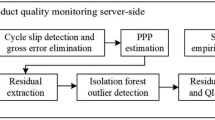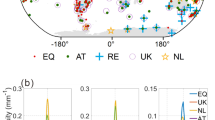Coordinate–time measurements are considered as one of the most common types of measurements in various radio navigation and radar systems in the field of geodesy and radio communications. It is shown that the increase in the number of coordinate–time measuring instruments, as well as the increased level of requirements for the accuracy of determining user coordinates, stipulated the relevance of the development of the State Primary Special Standard of Location Coordinates. The composition of the State primary special standard of location coordinates GET 218-2022, developed at VNIIFTRI, is presented, which will ensure the uniformity of measurements of coordinates and azimuth, satellite geodetic and navigation equipment using signals from global navigation satellite systems GLONASS, GPS, Galileo, BeiDou and ground augmentations. The metrological characteristics of GET 218-2022 in terms of storing absolute coordinates, reproducing/measuring the unsolicited range in phases of the ranging code and carrier frequency, reproducing the coordinates of the consumer of global navigation satellite systems, measuring increments of coordinates in coordinate systems are studied. The results of studies of the metrological characteristics of GET 218-2022 in terms of storing absolute coordinates and measuring increments of user coordinates showed a comparable level of accuracy with the characteristics of the international ITRS system. With the use of GET 218-2022, it is possible to test such promising measuring instruments as high-precision unsolicited measurement systems, precision receivers of global navigation satellite systems in the mode of absolute/relative phase measurements.




Similar content being viewed by others
Notes
GOST R 8.750-2011. GSI. State verification scheme for coordinate–time measuring instruments.
Order of the Federal Agency for Technical Regulation and Metrology dated September 1, 2022 No. 2175 "On Approval of the State primary special reference of position coordinates."
Coordinates and speed of ITRF2020 stations. URL: https://itrf.ign.fr/ftp/pub/itrf/itrf2020/ITRF2020_GNSS.SSC.txt (accessed 08/01/2022).
References
K. M. Antonovich, Ispol'zovanie radionavigacionnyh sistem v geodezii (The Use of Radio Navigation Systems in Geodesy), FSUE "Kartgeocenter" Publ., Moscow (2006), Book 1, 360 p.
G. Petit and B. Luzum, IERS Technical Note, No. 36, IERS Conventions (2010), available at: http://iers-conventions.obspm.fr/content/tn36.pdf (accessed: 08/01/2022).
Proceedings of the 24th Meeting of the General Conference on Weights and Measures (October 2011), available at: https://www.bipm.org/documents/20126/35657008/CGPM24.pdf/5cc3fc20-f45c-42f2-ea67-9b7f1e92408f (accessed: 08/01/2022).
Z. Altamimi, P. Rebischung, L. Métivier, and X. Collilieux, J. Geophys. Res.: Solid Earth, 121, No. 8, 6109–6131 (2017), https://doi.org/10.1002/2016JB013098.
D. S. Pecheritsa, GLONASS Receivers Calibration, J. Siberian Federal University. Engineering & Technologies, 12, No. 1, 126–131 (2019), https://doi.org/10.17516/1999-494X-0078.
A. I. Perov and V. N. Harisov (Eds.), GLONASS. Principy postroenija i funkcionirovanija (GLONASS. Principles of Construction and Operation), Radio Engineering, Moscow (2010), 800 p.
B. Hofmann-Wellenhof, H. Lichtenegger, and J. Collins, Global Positioning System. Theory and Practice, Springer-Verlag Wien GmbH (2001), 404 p., https://doi.org/10.1007/978-3-7091-6199-99.
A. I. Perov, GLONASS. Modernizacija i perspektivy razvitija (GLONASS. Modernization and Development Prospects), Radio Engineering, Moscow (2020), 1072 p.
J. Sanz Subirana, J. M. Juan Zornoza, and M. Hernández-Pajares, GNSS Data Processing. Volume 1: Fundamentals and Algorithms, ESA Communications, Noordwijk (2013), 223 p., available at: https://gssc.esa.int/navipedia/GNSS_Book/ESA_GNSS-Book_TM-23_Vol_I.pdf (accessed: 08/01/2022).
Peter J. G. Teunissen and Oliver Montenbruck (Eds.), Springer Handbook of Global Navigation Satellite Systems, Springer Cham (2017), 1327 p., https://doi.org/10.1007/978-3-319-42928-1.
Author information
Authors and Affiliations
Corresponding author
Additional information
Translated from Izmeritel'naya Tekhnika, No. 11, pp. 3–8, October, 2022.
Rights and permissions
Springer Nature or its licensor (e.g. a society or other partner) holds exclusive rights to this article under a publishing agreement with the author(s) or other rightsholder(s); author self-archiving of the accepted manuscript version of this article is solely governed by the terms of such publishing agreement and applicable law.
About this article
Cite this article
Karaush, E.A., Pecheritsa, D.S. State Primary Special Standard of Location Coordinates Get 218-2022: Study of Metrological Characteristics. Meas Tech 65, 787–792 (2023). https://doi.org/10.1007/s11018-023-02152-6
Received:
Accepted:
Published:
Issue Date:
DOI: https://doi.org/10.1007/s11018-023-02152-6




